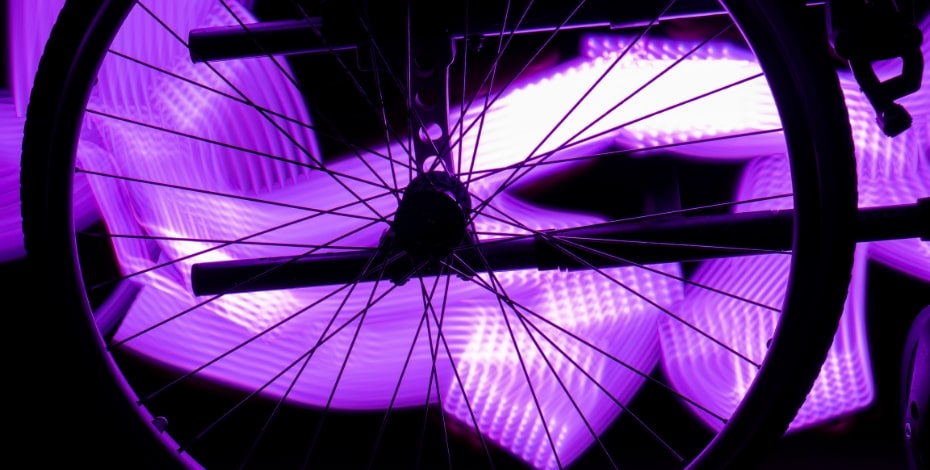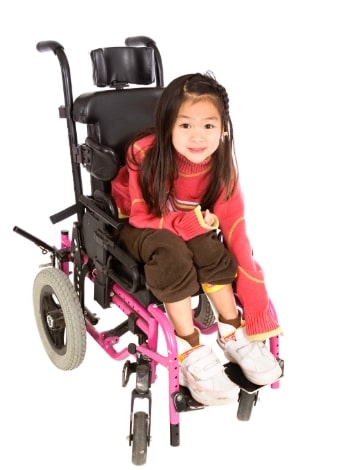
Physiotherapy and wheelchairs

Angela Rowe from the APA Disability group presents five discussion points about physiotherapists and their role in wheelchair assessment and prescription.
1. Using a powered mobility device as early as eight months old can enhance overall independence, development and participation
Research into early intervention has led to a focus on the early use of a powered mobility device.
An international consensus paper (Livingstone & Paleg 2014) presented multiple statements that can guide physiotherapy practice and challenge old paradigms.

Early access to a powered mobility device supports psychosocial development and functional mobility.
It was agreed that introducing a powered mobility device to clients as young as eight months old can support psychosocial development and functional mobility, without impeding the development of other motor skills (Livingstone & Paleg 2014).
Further research has shown that early powered mobility can assist cause-and-effect development (Livingstone & Paleg 2014) and encourage play skills (Guerette et al 2013).
In a comprehensive survey (Kenyon et al 2018), the consensus statements were provided to 1009 occupational therapists and physiotherapists, who reported that they essentially agreed with the principles.
The survey also showed that the average age of children commencing powered mobility was two years and three months.
Fifty per cent of respondents said that they didn’t provide these opportunities in their practice.
Butler (1986) identified that the use of powered mobility devices can provide young children with efficient, independent mobility, reducing their risk of developing passive, dependent behaviours.
Continuous development in the field of assistive technology brings new opportunities for physiotherapists to enhance client mobility and independence.
2. There are standardised assessments and outcome measures for assessing and prescribing wheelchairs
The International Classification of Functioning, Disability and Health (World Health Organization 2001) is a framework that can guide wheelchair assessments, incorporating information relevant to the client and their wheelchair.
Subjective assessment tools include the Wheelchair Outcome Measure (Mortenson et al 2007) and the Functional Mobility Assessment (Schmeler 2003).
Most importantly, capturing the client’s strengths and goals and understanding their lived experience with their wheelchair will lead the process.
A Clinical Application Guide to Standardised Wheelchair Seating Measures of the Body and Seating Support Surfaces (Waugh 2013) is a resource manual for implementing International Organization for Standardization standards.
It provides standardised terminology, angular and linear body measures and support surface measures.
Assessing selected measures and interpreting them within a wheelchair prescription is an essential part of the assessment process.
A MAT (mechanical assessment tool) evaluation (NSW State Spinal Cord Injury Service 2008) assesses a client’s posture and the influence of range of movement in sitting postural alignment.
The Goldsmith Indices of Body Symmetry have good inter-rater and intra-rater reliability for measurement of thoracic shape and symmetry, pelvic orientation and hip range (Holmes et al 2021).
This can be used to track a client’s postural changes over time (Holmes et al 2021) and apply these findings to their postural goals in sitting.
3. Physiotherapists can improve mobility and prevent falls through wheelchair set-up and adjustment
Manual wheelchair prescription can significantly influence a person’s level of independence and pressure injury risk.
Self-propulsion efficiency is a key consideration for wheelchair prescription and directly links to a person’s risk of shoulder joint pain (Beirens et al 2021) and median nerve dysfunction (Boninger et al 2000).

Self-propulsion efficiency is weighed against stability in decisions about manual wheelchair set-up and adjustment.
Changing the centre of gravity of a wheelchair and its user by moving the rear wheel forwards both increases a client’s self-propulsion efficiency and reduces their stability (Campo 2018, Hybois 2018).
Moving the axle position forwards and upwards improves multiple propulsion parameters, including reducing rolling resistance, forces and the number of strokes and improving overall propulsion efficiency (Freixes et al 2010).
The Paralyzed Veterans of America Consortium for Spinal Cord Medicine’s clinical practice guidelines ‘Preservation of Upper Limb Function Following Spinal Cord Injury’ (2005) have evidence-based recommendations on how to optimally set up a wheelchair for longer-term joint preservation, including axle adjustments.
Adjusting a wheelchair is highly individualised and mobility goals need to be weighed against a client’s stability (Hybois 2018).
An evaluation of a client’s wheelchair skills and establishing a falls history are an essential part of a wheelchair prescription.
Specific adjustments and product features can improve wheelchair stability (Campo 2018) and reduce the risk of falls.
4. Flat or solid tyres make manual wheelchairs harder to self-propel
A manual wheelchair may be well scripted and set up but remain hard for the client or carer to push if the tyres are solid or flat.
De Groot et al (2013) found that higher tyre pressure led to improved self-propulsion technique parameters, including a lower push frequency.
Energy expenditure increased at 50 per cent tyre inflation, with a 25 per cent increase in heart rate and oxygen consumption compared to using fully inflated tyres (Sawatzky et al 2005).
Physiotherapists can help to build capacity in their client’s wheelchair maintenance through education and/or assist with regular wheelchair reviews.
Wheelchair users are 44 per cent more likely to have shoulder pain than non-wheelchair users (Liampas et al 2021).
Shoulder pain has been found to be significantly higher in adult-onset wheelchair users than in childhood-onset users due to suggested biomechanical and behavioural adaptations (Sawatzky et al 2005).
Physiotherapists are well placed to complete musculoskeletal assessments and support the management of their client’s shoulder pain.
The set-up, adjustment and maintenance of their client’s wheelchair is crucial in managing propulsion-related repetitive strain.
Consideration of longer-term joint preservation strategies can include the prescription of power assist devices and powered wheelchairs.
5. Physiotherapists have a unique skill set for wheelchair assessment and prescription
A physiotherapist is a valuable member of a wheelchair and seating team, with a skill set that complements the skills of occupational therapists and rehabilitation engineers.
Physiotherapists have an in-depth understanding of their client’s strengths and participation goals and of mobility-related, postural, musculoskeletal and neurological influences on their client’s wheelchair positioning.

Childhood-onset wheelchair users are significantly less likely to experience shoulder pain than adult-onset wheelchair users.
Physiotherapists who work in the field of disability have expertise in areas that assist the wheelchair prescription process, such as disability-related health issues, restrictive practice, access and supported decision-making.
With new physiotherapists entering the disability and National Disability Insurance Scheme space, establishing scope of practice and setting up training opportunities for staff is paramount.
Training opportunities through the APA, the Oceania Seating Symposium in April 2022 and online training modules through the World Health Organization and the NSW State Spinal Cord Injury Service’s Spinal Seating Professional Development Program can assist skill development in this field.
Many equipment suppliers also provide free training opportunities with a product focus.
Having support and supervision through a clinical mentor or a professional group is highly valuable.
Given that some clients spend up to 16 hours a day in their wheelchairs, it is crucial for physiotherapy knowledge to be expanded in this important field.
Click here for an infographic poster based on this content.
>> Angela Rowe, APAM, works in wheelchair services at the Royal Melbourne Hospital and Monash Health and runs her own business, Postural Innovations. She completed postgraduate training in postural management in the UK and worked as a postural management therapist at the Royal Hospital for Neuro-disability in London. Angela has co-authored a wheelchair competency document at Monash Health and has been involved in research through the Royal Melbourne Hospital. She has a passion for upskilling physiotherapists in the field of wheelchair prescription and has run various workshops and lectures, including for the APA.
- References
Ali Lafta H, Guppy R, Whatling G and Holt C (2018) Impact of rear wheel axle position on upper limb kinematics and electromyography during manual wheelchair use. International Biomechanics; 5: 17-29
Askari S, Kirby L, Parker K, Thomspon K, O’Neill J (2013) Wheelchair Propulsion Test: Development and Measurement Properties of a New Test for Manual Wheelchair Users Archives of Physical Medicine and Rehabilitation 94 (9): 1690-1698
Beirens B, Bossuyt F, Arnet U, Van der Woude V, HK de Vries, W (2021) Shoulder Pain Is Associated With Rate of Rise and Jerk of the Applied Forces During Wheelchair Propulsion in Individuals With Paraplegic Spinal Cord Injury Archives of Physical Medicine and Rehabilitation 102 (5), 856-864
Boninger M, Baldwin M, Cooper R, Koontz, A and Chan L (2000) Manual wheelchair pushrim biomechanics and axle position. Archives of Physical Medicine and Rehabilitation 81 (5) 608-613
Butler C. Effects of powered mobility on self-initiated behaviors of very young children with locomotor disability. Dev Med Child Neurol 1986; 28: 325–32.
Campo Uribe J (2018). Identification and Visualisation of the Centre of Gravity of a Wheelchair User [Biomedical Engineering Capstone Project]. Melbourne, Vic: The University of Melbourne; 2018.
Consortium for Spinal Cord Medicine (2005). Preservation of Upper limb function following spinal cord injury: Clinical Practice Guidelines for Health Care Professionals
Curtis K, Roach K, Applegate E, Amar T, Benbow C, Genecco T and Gualano (1995) Development of the Wheelchair User's Shoulder Pain Index (WUSPI). Paraplegia; 33 (5): 290-3
De Groot S, Vegter R, Van der Woude L (2013) Effect of wheelchair mass, tire type and tire pressure on physical strain and wheelchair propulsion technique. Medical Engineering & Physics, 35: 1476-1482
Dubowsky S, Sisto S, Langrana N (2009) Comparison of Kinematics, Kinetics, and EMG Throughout Wheelchair Propulsion in Able-Bodied and Persons With Paraplegia: An Integrative Approach J Biomech Eng.131(2): 021015
Freixes O, Fernandez (2010) Wheelchair axle position effect on start-up propulsion performance of persons with tetraplegia Journal of Rehabilitation Research & Development 47 (7): 661–668
Guerette P, Furumasu J and Tefft D (2013) The Positive Effects of Early Powered Mobility on Children's Psychosocial and Play Skills. Assistive Technology: Resna; 25: 39-48
Holmes C, Fredrickson E, Brock K and Morgan P (2021) The intra- and inter-rater reliability of the Goldsmith indices of body symmetry in non-ambulant adults with cerebral palsy Disability and Rehabilitation; 43: 2640-2646
Haugh, A.B., Pandyan, A.D. & Johnson, G.R. (2006). A systematic review of the Tardieu Scale for the measurement of spasticity. Disability and Rehabilitation, 28(15), 899-907.
Hybois S, Bascou F, LavasteH, Sauret C (2018) Investigating the effects of manual wheelchair adjustments on locomotion stability through multi-factorial numerical simulations. Annals of Physical and Rehabilitation Medicine; 61: e88
Kenyon L, Jones M, Livingstone,R, Breaux B, Tsotsoros J, Williams K Power mobility for children: a survey study of American and Canadian therapists’ perspectives and practices Dev Med Child Neurol 2018; 60: 1018-1025
Liampas A, Neophytou P, Sokratous M, Varrassi G, Ioannou C, Hadjigeorgiou G and Zis P (2021) Musculoskeletal Pain Due to Wheelchair Use: A Systematic Review and Meta-Analysis. Pain and Therapy. 10: 973–984
Livingstone R, Paleg G. Practice considerations for the introduction and use of power mobility for children. Dev Med Child Neurol 2014; 56: 210–21.
MAT Evaluation Tool (2008): NSW State Spinal Cord Injury Service, Spinal Seating Professional Development Program http://www.aci.health.nsw.gov.au/networks/spinal-cord-injury/spinal
Mortenson, WB, Miller, WC, Miller-Pogar, J (2007) Measuring wheelchair intervention outcomes: development of the wheelchair outcome measure. Disability and Rehabilitation: Assistive Technology, 2 (5), 275–285.
Paralyzed Veterans of America Consortium for Spinal Cord Medicine (2005) Preservation of Upper Limb Function Following Spinal Cord Injury: A Clinical Practice Guideline for Health-Care Professionals J Spinal Cord Med. 28(5): 434–470.
Sawatzky, B. J., Slobogean, G. P., Reilly, C. W., Chambers, C. T., & Hol, A. T. (2005). Prevalence of shoulder pain in adult- versus childhood-onset wheelchair users: A pilot study. Journal of Rehabilitation Research and Development, 42(3), 1-8
Sawatzky B, Miller W and Denison I (2005) Measuring energy expenditure using heart rate to assess the effects of wheelchair tyre pressure. Clinical Rehabilitation; 19: 182-187
Schmeler MR (2003). Development and testing of a clinical outcome measurement tool to assess wheeled mobility and seating intervention. Doctoral Dissertation; 833
Smith E, Miller W, Mitchell I, Mortenson W, Mihailidis A (2020) Evaluation of the feasibility of an error-minimized approach to powered wheelchair skills training using shared control. Disability and Rehabilitation: Assistive Technology
Victorian Government (2016): Allied health: credentialling, competency and capability framework (revised edition); https://www2.health.vic.gov.au
Waugh K (2013) A clinical application guide to standardised wheelchair seating measures of the body and seating support surfaces. University of Colorado/Assistive Technology Partners Denver, USA.
Walford S, Requejo P, Mulroy S and Neptune R (2109) Predictors of shoulder pain in manual wheelchair users. Clinical Biomechanics 65: 1-12
Wheelchair Skills Test (WST) Version 5.2 Form (2021): Manual Wheelchairs Dalhousie University.
World Health Organization 2001. The International Classification of Functioning, Disability and Health (ICF). Geneva: WHO
© Copyright 2025 by Australian Physiotherapy Association. All rights reserved.





